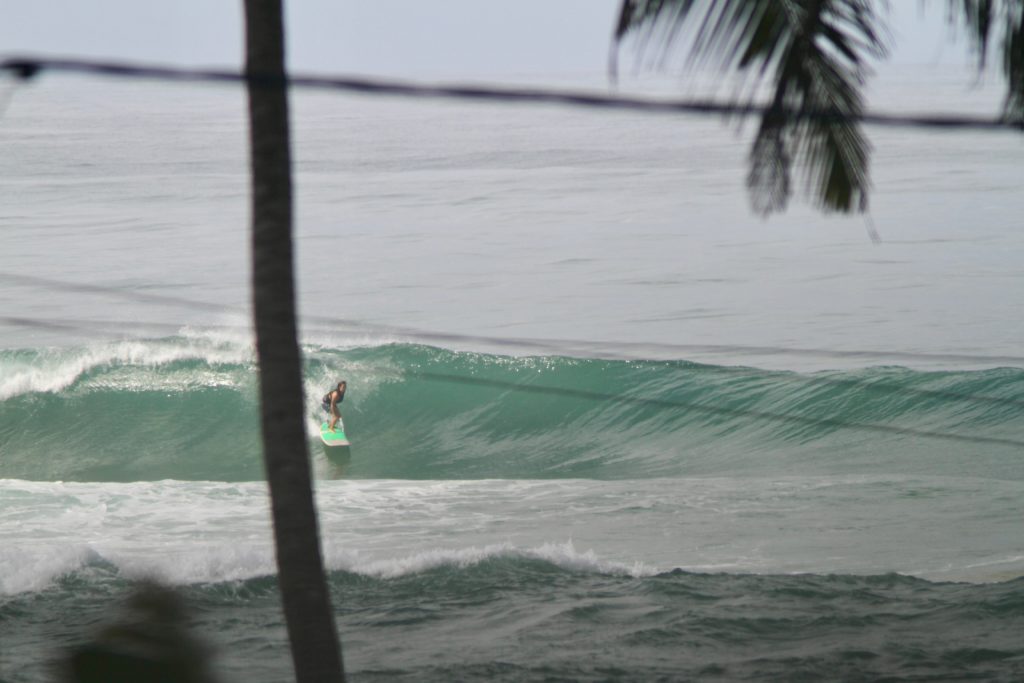We aim to be as transparent as possible when promoting the Ticket to Ride Surf House in Sri Lanka as well as the tours we operate, so that expectations are met and you can make the decision to join us when it works for you.
That being said the whole seasonal terminology is quite confusing, and the waves can also add confusion (the lead image was taken in the South Coast on May 14th!) so here’s an attempt to explain:
The Two Surf Seasons of Sri Lanka
Sri Lanka’s surf scene is divided by its two surfable coastlines: South (South West) and East. Thanks to the island’s unique weather patterns, there’s always a surfable coastline with clean waves and favourable winds, just not always the same one…
1. The South (from Bentota to Ahangama to Hiriketya and beyond)
- Best Surf Season: November to April
- Why: This is what a lot of people refer to as the “dry season” in the South, which means clean offshore winds in the mornings, consistent swell, and sunny skies.
- Conditions: Waist to overhead waves, with spots for all levels. Weligama / Kabalana are great for beginners, the waves in Ahangama are perfect for intermediate surfers and there’s a few punchier setups nearby also.
- However: Dewata Beach, Weligama Bay, Hiriketya and a few other places are actually better in the “off-season” months of May – October. This is because they face a different direction and these bays need big swell to work best, also the prevailing Westerly wind which accompanies the “off season” doesn’t affect the waves as much.
2. The East Coast (Arugam Bay and surrounding breaks)
- Best Surf Season: May to September
- Why: This is the official dry season on the east coast, bringing glassy conditions, extremely long waves, and consistent swell to Arugam Bay and its nearby points.
- Conditions: Arugam Bay is a right-hand point break that’s perfect for intermediate surfers looking to level up. More advanced surfers head to nearby breaks for some easy tubes.
- However: Arugam Bay receives a very small amount of rain compared to the South, with locals saying that it’s usually wet for only a couple of months per year, normally December and January and whilst the famous ‘Main Point’ doesn’t work, Baby Point further down the bay does break as do waves on the beach behind Arugam Bay.
When Should You Go?
It depends on what kind of waves you’re chasing, your skill level, and what else you’re looking for from your trip.
🏄♂️ Beginners
- Best Time: November to March (South)
- Why: Weligama and other south coast beaches offer gentle, forgiving waves perfect for beginners
- However: As you will most likely be surfing in Weligama or Dewata, these waves break year round, so you could join at any time of the year and have a great experience. The vibes in the towns like Ahangama and Weligama are a lot sleepier, which personally for me is a bonus but if you’re wanting a buzzing social experience, might not be for you.
🏄 Intermediate Surfers
- Best Time: March to April (South) or September (East)
- Why: These “shoulder season” months offer fewer crowds and clean, consistent surf on either coast.
- However: The East Coast usually starts to work in early April, so if you are hoping to get some of those long right handers, you can head to Arugam Bay around the Sri Lankan New Year (April 14th / 15th) and score. There will only be one wave working though (Main Point) as the sand won’t have built up in the surrounding breaks enough to create the banks that create the waves – these usually only start to work around the end of June.
🏄♀️ Advanced Surfers
- Best Time: April (South) or August / September (East)
- Why: April often sees the biggest swells in the south and August / September in Arugam Bay are full on swell magnets
- However: For the past few years the waves have been great in the South until mid May, with our not so secret secret spot in the lead image lighting up at this time every year. The waves around Arugam Bay get better as the season progresses, as the sand settles and the points get more groomed. There is a kind of crescendo of surf in early / mid October, where you can be surfing the waves of your life, then it will rain which will be accompanied by a storm and the season ends just like that.
 Nikita enjoying clean waves out the front of the Surf House in mid May
Nikita enjoying clean waves out the front of the Surf House in mid May
Bonus Tip: Monsoon Myths
Right, that term “monsoon season” doesn’t mean constant rain. While it does bring wetter weather and more onshore winds to the affected coastline, it isn’t all day, every day, it might be a morning, afternoon or evening tropical shower, maybe a full on storm that does last a day or two, but it will pass.
October and May are the wettest months in the South and December / January in the East.
To summarise, the main thing to takeaway is that if one coastline is experiencing its “monsoon season” the opposite coast will be dry, sunny, and offshore at the same time and if you do find yourself in one of the surf towns during their “off season” you will be experiencing what it felt like to be in Sri Lanka 15 years ago.
Got it?